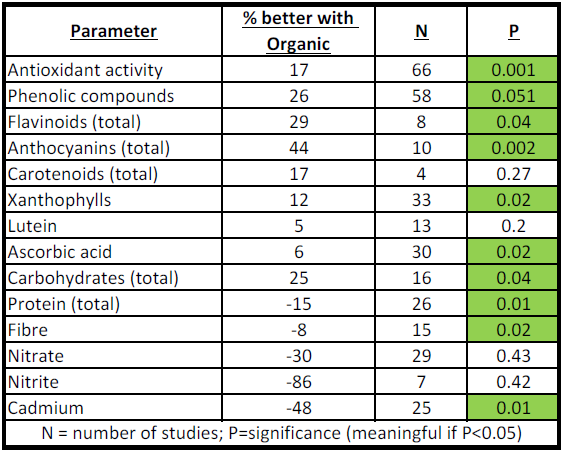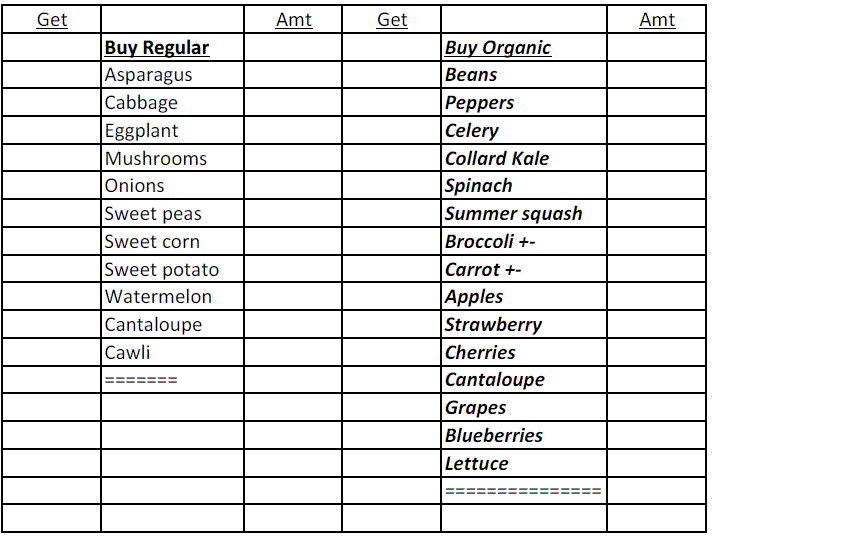Organic vs Conventional Produce
It is reasonable to ask if there is any advantage of organic fruit and vegetables over conventional ones. The 3 minute video below gives the simplest answer (it’s about avoiding pesticides):
Once you have seen this video, it is reasonable to ask if organic produce also has pesticides – see the 3 minute video below for the answer:
Here is a link to a video which looked at the pesticide levels in the urine of children fed conventional and organic produce (another paper here). A prospective study looked at levels of urinary metabolites of organophosphorus pesticides in 23 children (age 3-11) who consumed only conventional diets (ie no organic fruit or vegetables) over a period of one year (see reference 3). Samples were collected for 7, 12, or 15 days during each of the four seasons. A novel aspect of this study is that children were switched to organic diets for 5 consecutive days in the summer and fall sampling seasons. During these 5 days, the median urinary pesticide metabolite levels were reduced to non-detected or close to non-detected for both metabolites. In the discussion, the authors stated however that it was not clear that the levels of metabolites in the children’s urine for the rest of the year were known to be harmful.
A systematic review of the literature was published in the British Journal of Nutrition in 2014 (1) which aimed to look at the literature to see if there are significant nutritional differences between organic and non-organic foods. It specifically focused on plant secondary metabolites (eg antioxidants, polyphenols and vitamins), chemical pesticides and toxic metals (eg Cd, As, Pb), nitrite, macronutrients (proteins, amino acids, carbohydrates) and minerals. Papers were included if they looked at the concentrations of at least one mineral, macronutrient, metabolite, or the frequency of occurrence of pesticide residues in organic and conventional crops. A total of 343 studies were found and included in the analysis. While some of the studies looked at organic vs regular farms, other studies looked at retail produce which was labelled as organic vs regular produce.
Below is a table that I made from the paper looking at the levels of antioxidants, secondary metabolites, macronutrients, nitrogen, and cadmium in organic vs regular produce.

As you can see, organic produce was significantly better (P<0.05) in terms of antioxidant activity, phenolic compounds, flavinoids, acanthocyanins, xanthophils, ascorbic acid (vitamin C), vitamin E, and carbohydrates. Organic produce also had lower levels of cadmium which is a highly toxic metal and one of the only three toxic metal contaminants (the others are lead and mercury) for which the European Commission has set maximum residue levels in foods.
This study also looked at the studies which measured the frequency of pesticide residues in organic and conventional crops:

As you can see, there conventional fruit has a 65% rate of samples positive for pesticide, and for vegetables the difference is 22%. The presence of detectable pesticide residues in 11% of organic crop samples may have been due to cross-contamination from neighbouring conventional fields, the continued presence of very persistent pesticides (eg organochlorine compounds) in fields and/or accidental or fraudulent use of prohibited pesticides in organic farms. This raises the question to ask of whether the increased levels of pesticides found in some conventional produce has adverse effects on our health – it is possible that these pesticides are not harmful or are present in safe levels.
A new issue which has come up is dessication – the application of herbicide to crops at harvest time. The purpose is to kill all the plants at the same time, making them uniformly dry and easier to cut. Crops which undergo dessication include lentils, peas, soybeans, corn, flax, rye, buckwheat, oats, canola, millet, sugar beets, potatoes, and sunflowers. A product commonly used in this process is glyphosate (RoundUp) which is the most commonly used herbicide and dessicant in the world. In the US the use of glyphosate grew by 356% from 1995 to 2004 and then by another 637% from 2005 to 2014. For more information see here. The scope of this problem is sadly outlined in this report on contamination of breakfast cereals. The only way I know to avoid dessicants like this is to buy organic.
I came across a nice database of studies looking at pesticide-induced diseases (click on the particular disease you are interested in in the left margin) as well as another database of the carcinogenic risks of different chemicals. Click here for a summary of the findings in this database as of 2010. In their position statement on pesticide exposure in children, the American Association of Pediatrics say, “For many children, diet may be the most influential source [of pesticides]” (also here). As this recent article (October 2018) shows, there is growing evidence that those who consume organic produce also have a lower risk of cancer.
My response to the above information has been to try & buy organic produce for fruit/vegetables that are known to have a lot of pesticide on them. A good list of this information is available from the Environmental Working Group which also have the information in a free app. Sadly there are even more foods which should be on this list including dried bean & lentils (see here) which I now suggest you buy organic. For more information see the following information from the Mayo Clinic and University of California at Davis.
If you are wondering how reliable organic labelling is, I came across a nice simple guide to that here.
Below is a copy of the shopping list that I made taking into account produce which is high and low is pesticides:

For those wishing to dig deeper, please see reference 4 which is a recent report on the damage to human health from existing industrial and chemical-intensive conventional food and farming systems (overview here).
References
- Higher antioxidant and lower cadmium concentrations and lower incidence of pesticide residues in organically grown crops: a systematic literature review and meta-analysis. M Baranski et al. Br J Nutrition 2014:112:794-811
- Pesticides in My Drinking Water ? Drew Toher. Pesticides and You 33:2 (Summer 2013).
- Dietary Intake and its contribution to Longitudinal Organophosphorus Pesticide Exposure in Urban/Suburban Children. Lu C, Barr DB,Pearson AM, Waller LA. Environ Health Perspect 2008:116:537-542.
- Report of the Special Rapporteur on the right to Food. United Nations, January 2017.
Thank you for information
thanks again for all your efforts
you are making a difference
Thanks for the encouragement – so are you !
This was helpful.